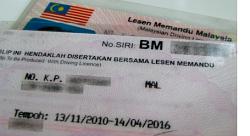 Next month will see the introduction of a high-security driving licence, which will feature improved security measures and durability. The new style licence replaces the current laminated one, which has been around since 1989.
Next month will see the introduction of a high-security driving licence, which will feature improved security measures and durability. The new style licence replaces the current laminated one, which has been around since 1989.
According to reports, the Road Transport Department (JPJ) will begin issuing the licence from July 15 at all it offices nationwide, though post office branches will only start doing so from November.
Acting Transport Minister Datuk Seri Hishammuddin Tun Hussein said the new licences will be printed using thermal transfer technology, and that a high security holographic layer would protect the driver’s information and photograph.
He said that the details on it would be printed in both Bahasa Malaysia and English to allow international recognition, and added that the switch to the new licence will not involve an additional fee – it will be maintained at RM30 a year.
The new licence will be implemented for all private vehicles owners, including car and motorcycle users for both probationary (P) and normal driving licence categories, the reports add. Switching to the new one is not compulsory as long as the current one is still valid.
Looking to sell your car? Sell it with Carro.











AI-generated Summary ✨
Comments express mixed reactions towards the implementation of high-security driving licenses from July 15. Many welcome the move, appreciating the increased security and the possibility of integrating licenses into MyKad, which would reduce carry-on items. Some are concerned about overseas travel issues, noting that current licenses lack standardization and may be difficult for foreign authorities to interpret. There are suggestions to adopt more durable, US-style licenses or a combined all-in-one electronic card, emphasizing convenience and global standards. A few critics question the actual benefits, citing issues like road safety, system delays, costs, and the reliability of government proposals. Overall, while many see the initiative positively, opinions highlight concerns about practicality, security, international recognition, and existing system limitations.